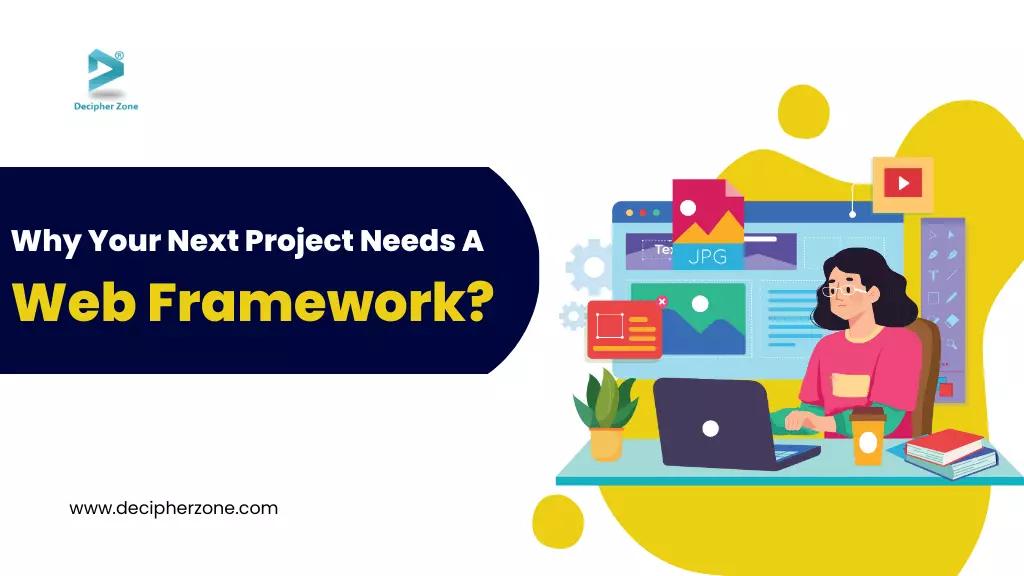The world of web app development is continuously changing and to stay ahead of the competition integrating frameworks to streamline the development process has become a necessity. In this blog, we will cover the fundamentals of web app frameworks, explaining the components, types, features, benefits, top choices, tips to choose the right one, and so much more.
Do you feel compelled to find ways to make that web application development a little easier? Well, when designing and building a web application, this is one of the most common problems. No one wants to write the same code repetitively over and over again, as it creates a ton of inconsistencies in the codebase, leading to potential bugs and performance errors.
Needless to say, you are not the first programmer to face this issue, there were a lot of them - those frustrated fellas. But to make things easier for next-gen developers like you, they have come up with the concept of frameworks and built multitudes of them, making web development easier and faster than ever before.
In this blog, we are going to cover different aspects of web frameworks, including but not limited to:
-
What web frameworks are;
-
What are the core web framework components;
-
What are the different types of frameworks available in the market;
-
Why you should use web frameworks;
-
How to choose the right frameworks for your project;
-
What are the most popular frameworks to go for;
-
How to implement frameworks in the web development process; and
-
What are some common challenges you might face and how to overcome them?
What are Web Development Frameworks?
If we look at the definition, web development frameworks refer to the set of tools and resources that help developers create and handle web apps, websites, APIs, and web services development. These frameworks aim to automate the most common tasks that developers typically perform iteratively by offering standardized methods to build, maintain, and deploy a web app.
Does that make sense to you? A little bit? If you are new to the web development field, it can be quite difficult to grasp the concept.
In much simpler words, a web framework is like the strong skeleton on which developers can build web applications. It provides the basic structural foundation along with some tools, resources, and conventions to make the development process effortless. You can think of it as a set of pre-built components and helpful guidelines that enable more focus on developing new features in the web app rather than remodeling the same old wheel.
Core Components of Web Frameworks
As one starts on the web development journey, understanding the core components of web frameworks will help in creating efficient and secure applications.
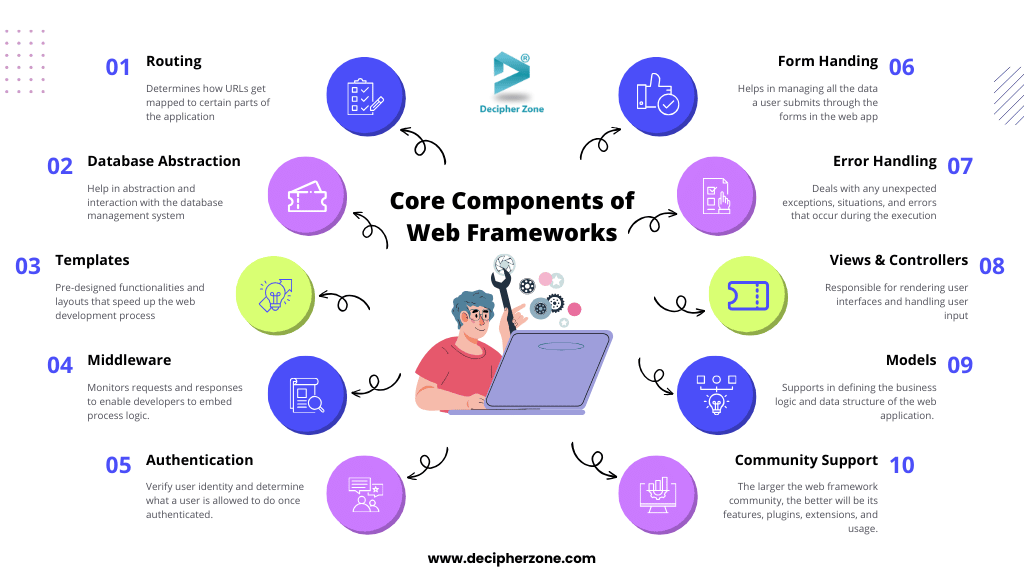
1. Routing
Web frameworks often use a routing system that determines how URLs get mapped to certain parts of the application, directing incoming requests to the appropriate controller or handler on defined rules. It organizes the entire web application structure for easier content access.
2. Database Abstractions
Handling database connections can be complex. However, integrating the abstraction layer can simplify interactions and improve data security. Web frameworks have tools that help in abstraction and interaction with the database management system for effortless data storage, retrieval, and management.
3. Templates
Another important component that web frameworks have are templates. By data embedding, these templates allow programmers to develop dynamic HTML pages. These templates have pre-designed functionalities and layouts that speed up the web development process through quick customization capabilities. Templates separate the presentation layer from the code one, making web app maintenance and updation a lot easier.
4. Middleware
As the name suggests, middleware components are the ones that sit right in the middle of the server and the application. It monitors requests and responses to enable developers to embed process logic at different request-response stages for easier authentication, data modification, and logging.
5. Authentication & Authorization
The purpose of these components is to verify user identity and determine what a user is allowed to do once authenticated. Authentication works similarly to the bouncers standing at the club entrance to check the IDs of the visitors before granting club access. With authorization, the web app determines the permission that the user has and provides role-based access control to protect data integrity.
6. Form Handling
Form handling is yet another useful component that most web frameworks offer. It helps in managing all the data a user submits through the forms in the web app. With form validation the submitted data gets checked to ensure its validity, prevent any security vulnerabilities, and assure data consistency.
7. Error Handling
Next comes the error handling component in web frameworks. This component deals with any unexpected exceptions, situations, and errors that may occur during the execution of a web app. It provides valuable feedback when something goes wrong, helping to prevent system crashes. Error handling acts as a safety net for the code, identifying/alerting when anything goes wrong, and helping users understand the problem.
8. Views & Controllers
These components are responsible for rendering user interfaces and handling user input from URLs or forms. They facilitate request processing, data model interactions, application flow control, and presentation logic.
9. Models
Models help in defining the business logic and data structure of the web application. They also encapsulate how data gets stored, accessed, and manipulated, ensuring data integrity and consistency. It acts as a shield between your code and the database.
10. Community
Every web framework thrives with active communities of developers and industry experts. The larger the web framework community, the better will be its features, plugins, extensions, and usage.
P.S. Remember, these components work in a choreographed fashion to help developers create vigorous websites and web applications.
Types of Web Frameworks
Learning just the core components of the web frameworks is not enough. To choose the right web framework, you also need to know about the different types of frameworks in the market and their purposes.
Web frameworks are categorized into two categories, i.e., frontend and backend, both of which serve different purposes in the web development process.
1. Frontend Frameworks:
Client-side frameworks are the ones used for managing web application interfaces and experience. You can think of them as an artist painting the canvas, the only difference is they make magic happen on the web pages. They work on elements like images, animations, forms, buttons, text, and more, ensuring that the page not only looks pretty but also loads smoothly.
2. Backend Frameworks:
Server-side frameworks are the ones that work behind the scenes to make the magic come to life. Using backend frameworks, developers work on the server side of the web application that’s invisible to the user and handles tasks like authentication, database management, HTTP requests, security, and URL mapping. By providing a standardized and structured approach to building web applications, these frameworks simplify the development process and enable developers to concentrate more on business logic and shaping the output data.
Web Frameworks Features
Web frameworks come with a multitude of features that simplify development and reduce the time to market. Some of these features are enlisted below:

1. Structure
Web frameworks provide a structured foundation for web app development that encourages consistency in maintaining code, files, and directories. They also facilitate the creation of user interfaces.
2. Component-based Architecture
This feature, found in almost every modern framework, allows developers to break the user interface into reusable components. These components can then be reassembled to match the business needs.
3. User Experience Handling
Frontend web frameworks help developers create interactive and responsive UIs that adjust to different screen sizes. It also helps them oversee event processing, client-side interactions, and user input, ensuring a seamless user experience.
4. Server-Side Rendering
Web frameworks come with pre-rendered material that allows search engines to crawl and index all the pages of the website and web apps. This, in turn, speeds up the page loading time and improves the SEO of the web app.
5. Data Binding
This feature of the framework allows developers to connect UI with the data, guaranteeing instant updates to the web app interface when data changes and vice versa.
6. Data Handling
Web frameworks come with tools to retrieve, process, and store data from databases, APIs, and other sources, enabling efficient data storage, transformation, and validation.
7. Routing & URL Handling
Another useful feature that frameworks come with is the seamless handling of URL routing, managing HTTP requests based on the methods (GET, POST, PUT, DELETE), corresponding to the requested URL, and sending inbound requests to the right endpoints.
8. Performance Optimization
These frameworks also offer tools, resources, and methods to improve web app performance, boost responsiveness, and reduce latencies.
Benefits of Using Web Frameworks
Some of the advantages of using web frameworks for web development are as follows:
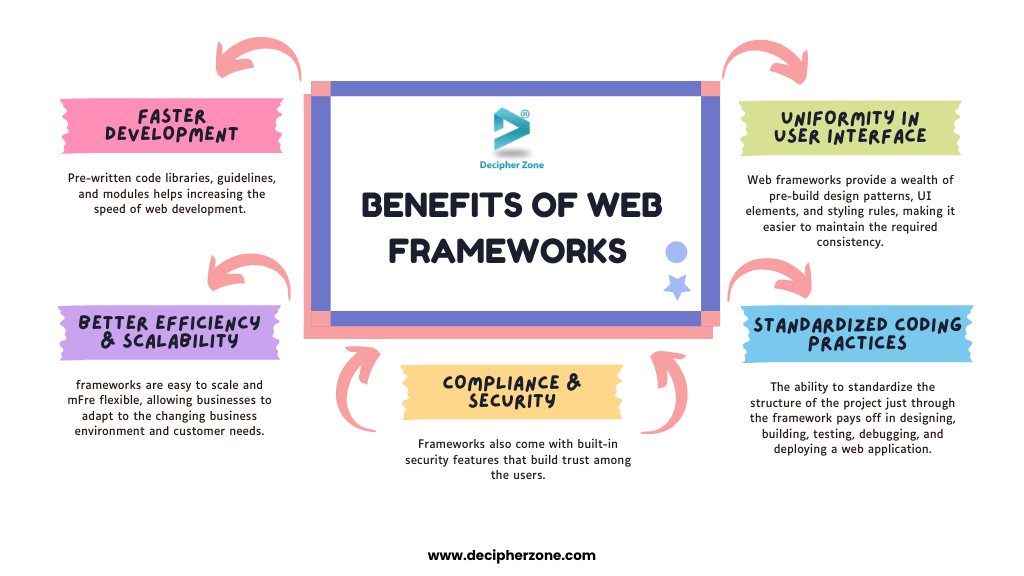
-
Faster Development: As web frameworks facilitate pre-written code libraries, guidelines, and modules to programmers, the development process of web applications and websites becomes much faster and easier. It also helps maintain the scalability, adherence, and adherence to industry standards.
-
Better Efficiency & Scalability: Web frameworks give an organized base in the form of pre-built components and tools that speed up business growth. This, in turn, shortens the time to reach the target audience. In addition to that, frameworks are easy to scale and more flexible, allowing businesses to adapt to the changing business environment and customer needs.
-
Compliance & Security: Frameworks also come with built-in security features that build trust among the users. It helps programmers design and develop web apps that are highly secure for businesses that deal with the private information of the customer like date of birth, government IDs, and other sensitive information. In short, web frameworks increase the security of the application data. This adherence to industry standards helps avoid any legal and financial consequences in case of data breaches.
-
Uniformity in User Interface: To build a brand image and maintain customer loyalty, it is essential to have uniformity in the user experience. Web frameworks provide a wealth of pre-build design patterns, UI elements, and styling rules, making it easier to maintain the required consistency by customizing the themes and features as per the business needs, ensuring the best possible user interface and interactions.
-
Standardized Coding Practices: When the web framework is chosen based on its capabilities, it can bring the possibility of creating a well-defined structure to follow in the project development lifecycle. The ability to standardize the structure of the project just through the framework pays off in designing, building, testing, debugging, and deploying a web application.
Top 10 Web Frameworks You Can Consider for Your Next Project
Below we have enlisted the top web frameworks that you can explore to find the one that meets your unique business requirements the most.
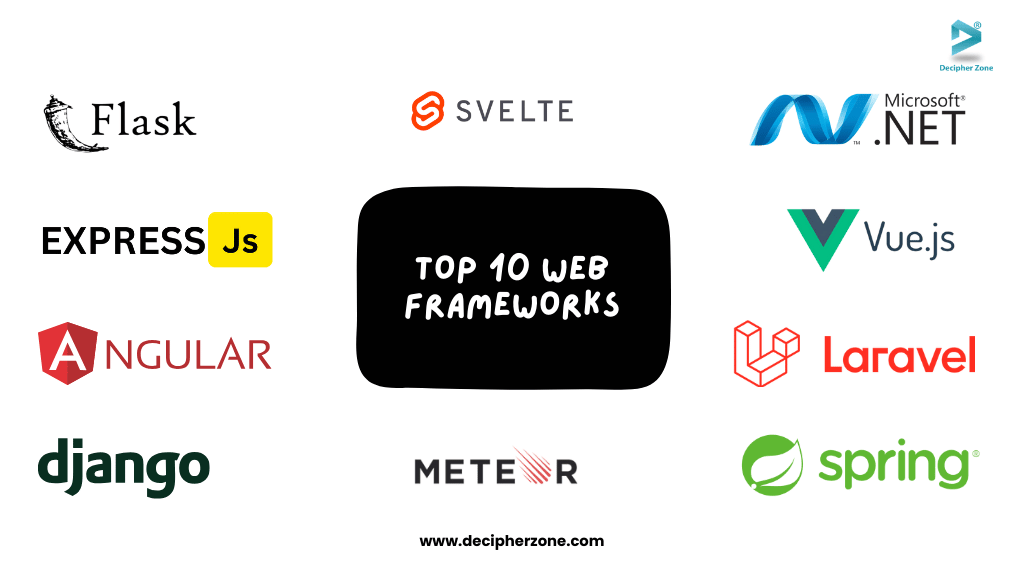
-
Flask
It is a lightweight framework that is written in Python. Flask is easy to use and is suitable for small to mid-sized projects. It doesn’t have any strict conventions that give the developers more control over features and functionalities. It is popularly used for APIs, prototyping, microservices, and smaller web app development.
-
Express.js
Express.js is a flexible and minimalistic web framework based on Node.js that provides a wide range of features to web apps, backend services, and APIs. It focuses on simplifying middleware handling, routing, and request/response management.
-
Angular
AngularJS or Angular is a TypeScript-based framework by Google. It provides an extensive set of solutions for developing RESTful APIs and complex web apps. The strong opinion of Angular on architecture along with its tools, makes it the right choice for large-scale projects.
-
Django
Django is a high-level, Python-based web framework that is known for its “batteries-included” philosophy, i.e., it comes with everything that you will need to develop a web app for your business. Django follows the model-template-view architecture to handle database structure and data logic. It’s popularly used to develop almost every website and web application - from CMS to Wikipedia.
-
Svelte
Svelte is a component-based, open-source, and free client-end framework that provides a unique approach to building web apps. Unlike other popular frameworks, Svelte does most of the work in compiling steps that happen when developing your app rather than doing that on the user’s browser. It can be used to develop small UI components, low-power devices, and web applications. Remember it is a relatively new framework, so it is still growing in terms of tools, community support, and plugins.
-
ASP.net Core
.Net is a proprietary framework developed by Microsoft that is used to develop cross-platform web apps using C# and F#. It primarily runs on Microsoft Windows. It is one of the most popular, highly modular frameworks, enabling developers to choose the components that meet their requirements. The .Net framework has two major components, i.e., Common Language Runtime and Class Library. It is well-integrated with Azure services and Visual Studios. It can be used to build Enterprise Applications, IoT apps, gaming apps, microservices, and web apps.
-
Vue.js
Vue is a progressive JavaScript framework renowned for its flexibility and simplicity. Developers can easily implement Vue.js into their projects whether small or large. It comes with component-based and reactive data binding, similar to React but with an easier learning curve. Using Vue.js, one can build UI for native and web apps.
-
Laravel
Laravel is an open-source framework written in PHP. It is used for developing web applications. It follows the model-view-controller architecture design pattern that organizes the logic of the application into distinct layers that carry the given set of tasks. It is commonly used for simplifying web development, building web applications, extending IDE capabilities, providing authentication systems, and supporting multiple file systems.
-
Spring
Spring is a Java framework that offers extensive support for building enterprise-level web applications. It simplifies dependency injection, security, and data access management. Spring concentrates on enterprise application development, allowing the team to prioritize the app's business logic without being overly bound to deployment environments.
-
Meteor
Meteor is more than just a web framework, it is a complete platform designed to simplify the development process through powerful features and tools. With Meteor, developers can work on both the front and back end of the application using JavaScript. It can be used for prototyping, MVPs, real-time applications, mid-sized projects, eLearning platforms, and internal dashboards and tools.
Tips to Choose the Right Frameworks for Web Development
Selecting the ideal framework for the project can be a hustle when there are a plethora of options around you. To make things easier for you, below are the key tips to consider before choosing a framework.
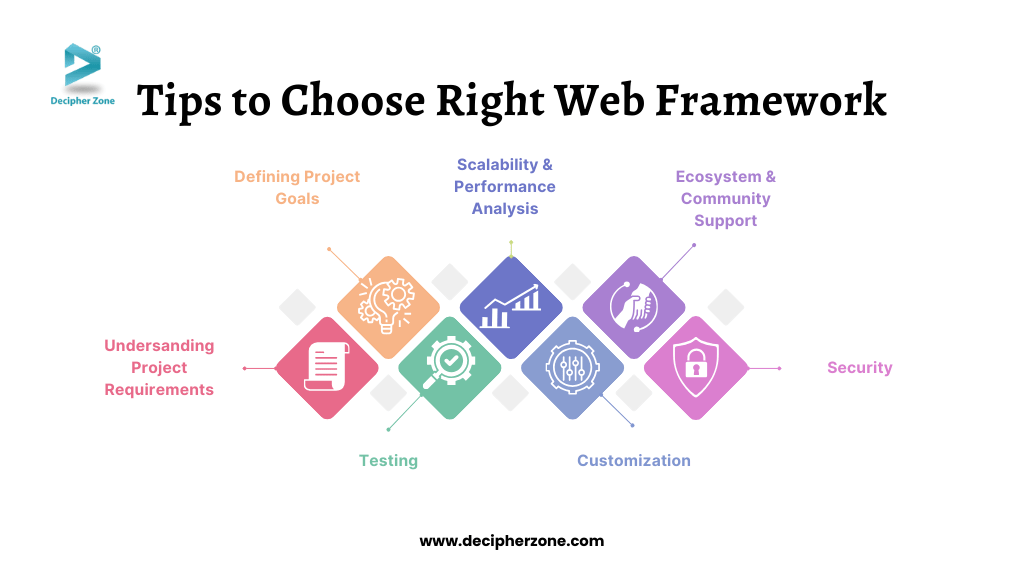
1. Understanding the Project Requirements
Before choosing any framework for your project, it’s crucial to know what you want to achieve through it. Some of the questions you should spend some time answering include:
-
What type of website or web app do you want?
-
What features and functionalities does your project require?
-
What are the technical constraints you are facing?
-
Is there any tech stack you want to avoid or use?
-
How much scalability and performance needs do you have?
-
What’s your budget and timeline for the project development?
2. Defining Project Goals
Once you have answered the questions shared above, you need to outline the goals and objectives of the project. Some of the goals you can/might have include streamlining processes, increasing user engagement, reaching a wider audience, boosting revenue, etc. Make sure that you define every objective in a measurable way to make the development process more efficient and faster.
3. Scalability & Performance
Other essential considerations when it comes to finding the right web framework are the scalability and performance it offers, especially if you plan to grow your business over time. In simple terms, you need to ensure that the framework you choose can handle the large volume of data and traffic through caching, scalability, load balancing, and other performance features.
4. Ecosystem & Community Support
Evaluating the community system of the given framework will be a fruitful move. Active and strong community support along with a powerful ecosystem that includes a wide range of plugins, libraries, and tools can do wonders for the project development process. How? Well, the potent community system will ensure that the framework stays updated, well-documented, and secure while the extensive ecosystem will speed up the development by offering simple solutions to common issues.
5. Security
With the changing tech-driven environment, securing the data collected from user interactions becomes essential. Having a web framework that facilitates built-in security features and the capability to resolve security vulnerabilities effortlessly will be a boon to your business.
6. Customization
Every business and its project have different requirements. Therefore, the web framework that you choose should be flexible enough to be customized based on your needs. Check if the framework allows easy modification of the existing components, extension of existing functionalities, and addition/removal of components and features. If the framework has the ability to adapt to the project requirements, it’s your sign to go for it.
7. Testing
Last but not least, the testing capabilities of the framework play a vital role when opting for the right one. A framework consisting of good testing support can help quick error detection and debugging, leading to the development of a reliable web app in a short time.
What Can You Build Using Web Frameworks?
Web frameworks open the door to a vast field of options where they can be used, allowing developers to bring diverse online experiences faster than ever before. Some of the use cases of web frameworks are as follows:
-
Single Page Applications: Loads a single page and updates the content as requested without reloading the page.
-
Content Management Systems: CMS helps users create, modify, publish, and organize digital content without the need for technical expertise.
-
Social Media Platforms: Digital platforms that allow user interaction with other users and content posted by them.
-
Enterprise Web Applications: Scalable web apps that are designed to meet enterprise needs like improving engagement and communication.
-
Progressive Web Apps: PWAs combine the best features of a native app and a website to boost user engagement and experience.
-
Gaming Platforms: Platforms built to play different games online through an active internet connection on a web browser.
-
eLearning Platforms: Interactive web apps that enable users to learn different courses online.
-
Real-time Web Applications (Chat & Messaging web apps): Designed to function within the given time frame and enable interactive user interaction.
-
API-driven Web Applications (Maps, Twitter, and Weather): Prioritizes smooth data transfer between different software components.
Decipher Zone: Your Trusted Tech Solution Partner
To create a web app using any web framework, hire a team of skilled developers. Hiring an in-house team can put a giant hole in your pocket and take a lot of time. However, outsourcing to a web app development company like Decipher Zone can deliver the desired results within your budget without the hassle of hiring and managing the in-house development team.
Key Takeaway
Web frameworks are an essential part of the web application development process. Using the frameworks makes it effortless and efficient for developers to streamline the development process while minimizing errors. Developers who are familiar with the core components and types of web frameworks choose the right one for your project, promoting security, reliability, scalability, and performance. Moreover, with framework-standardized coding practices, developers can easily customize the web apps, facilitating rapid testing, error detection, and debugging. The overall versatility of the web frameworks makes them suitable for a wide range of web applications, from single-page applications to e-learning platforms.
If you are interested in developing your web app using these frameworks, please contact our experts through the “Let’s Connect” page to hire skilled developers today!
People Also Ask
1. What is a web application framework?
Web development frameworks refer to the set of tools and resources that help developers create and handle web apps, websites, APIs, and web services development.
2. What are the top web frameworks?
Flask, Angular, Vue, Django, Svelte, and Express.js are some of the most commonly used frameworks out there.
3. How to choose a web framework?
When choosing the right web framework for your project, it's essential to consider various factors such as understanding project requirements, defining project goals, and evaluating the framework's scalability, performance, ecosystem, community support, security, customization options, testing features, and documentation.

